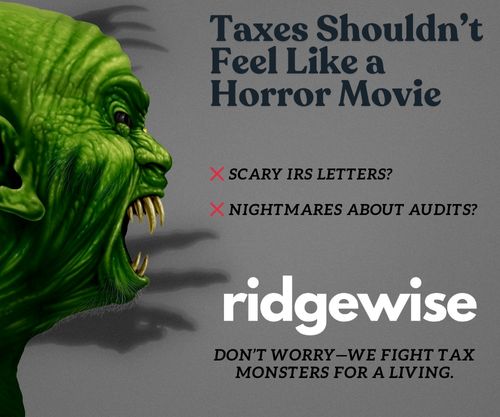Form 2210 is crucial for taxpayers who underpay their estimated taxes, affecting nearly 30% of individuals each year. This form helps you calculate any penalties owed and ensures you’re compliant with IRS regulations. Understanding its nuances can save you from unexpected costs and keep your finances in check.
Ridgewise can assist you in navigating the complexities of Form 2210 and other tax-related matters. Our expert team is dedicated to providing personalized support tailored to your specific needs. Studies show that professional tax guidance can reduce errors by up to 50%, helping you avoid costly mistakes. While other firms may offer basic services, Ridgewise goes the extra mile, ensuring you fully understand your obligations and opportunities.
With our commitment to clarity and accuracy, you can confidently tackle your tax responsibilities. Let’s explore how Form 2210 can impact your financial strategy.
What Is Form 2210?
Form 2210 is an IRS form used to determine if you owe a penalty for underpaying estimated taxes. This form is crucial for taxpayers who don’t withhold enough tax from their income throughout the year. You can use Form 2210 to calculate your underpayment penalty, ensuring you stay compliant with IRS regulations.
Form 2210 consists of different sections, including instructions and worksheets for calculating your tax liability. You must report your income, estimated tax payments, and any withholding amounts that apply to your situation. The IRS assesses penalties based on the amount of tax you owe and the duration of the underpayment period.
Form 2210 isn’t only for individuals; businesses can also use it if they fail to make adequate estimated tax payments. The IRS provides additional guidance through its instructions for Form 2210, detailing how to complete each section accurately.
Ridgewise supports you by offering bookkeeping services that ensure precise tracking of your income and tax payments. With professional assistance, you can minimize errors, comply with IRS requirements, and avoid unexpected penalties. Ridgewise’s team is ready to help you navigate the complexities of Form 2210, helping both individuals and businesses maintain effective financial management.
Purpose Of Form 2210
Form 2210 serves to calculate penalties for taxpayers who underpay their estimated taxes. Understanding this form is crucial for compliance with IRS regulations, particularly for individuals and businesses that struggle to withhold enough tax throughout the year.
Underpayment Penalties
Taxpayers face penalties when they underpay their estimated taxes. The IRS imposes these penalties based on the amount of tax owed and the length of time the payment remains unpaid. If your total tax payments are less than 90% of the tax shown on your current year’s return or less than 100% of the prior year’s tax, you might incur a penalty. Understanding how these underpayment penalties apply can save you from unexpected financial consequences.
Calculation of Penalties
Calculating penalties involves reviewing your estimated tax payments in relation to your total tax liability. The IRS generally calculates the penalty for each payment period where you underpaid. To determine the penalty amount, follow these steps:
- Determine the total underpayment for the period.
- Identify the number of days the tax remains unpaid.
- Calculate the penalty using the IRS’s interest rate for underpayments, which typically adjusts quarterly.
Ridgewise’s bookkeeping services can help you accurately track tax payments and assess potential penalties. By relying on professional guidance, you avoid costly mistakes and ensure compliance with IRS rules, leading to better financial management.
Who Needs To File Form 2210?
You must file Form 2210 if your total tax payments are less than the required thresholds set by the IRS, resulting in an underpayment. This includes both individuals and businesses. Specifically, if you fall into any of these categories, filing becomes essential:
- Self-employed individuals pay estimated taxes without withholding from their income.
- Individual taxpayers who receive income from multiple sources may not withhold enough throughout the year.
- Businesses that expect their income to fluctuate significantly might fail to pay adequate estimated taxes.
- Individuals with capital gains or pensions might see increased income that wasn’t accounted for during regular withholding.
Taxpayers who underestimated their tax liability might also find themselves in need of this form. If your total tax payments fall below 90% of the current year’s tax or below 100% of last year’s tax, you incur a penalty.
Ridgewise assists individuals and businesses in accurately calculating their estimated tax obligations and determining the necessity to file Form 2210. Our bookkeeping services facilitate precise tracking of income and payments, ensuring compliance with IRS regulations and reducing the risk of penalties. We help you manage your financial obligations efficiently, minimizing potential errors in tax filings.
How To File Form 2210
Filing Form 2210 involves several steps to ensure accuracy in determining any penalties related to underpaid estimated taxes. Understanding each component simplifies the process significantly.
Completing The Form
Begin completing Form 2210 by gathering relevant financial documents. You’ll need your income statements, estimated tax payments, and any applicable withholding amounts. Every section of the form requires precise input to assess potential penalties accurately. Use the IRS guidelines to navigate the specific figures required in each part. Calculate your total tax liability for the year first, then work through the sections that address your estimated tax payments. Ensure you check all applicable boxes to properly indicate your situation.
Ridgewise can assist you in preparing and completing Form 2210 correctly. Our bookkeeping services help track financial data and ensure all necessary information is provided, reducing the risk of errors.
Key Information Required
When filling out Form 2210, include specific information to determine if penalties apply. You need the following details:
- Tax Liability: Total taxes owed based on your income.
- Estimated Payments: Amounts you’ve paid in estimated taxes throughout the year.
- Withholding Amounts: Total taxes withheld from your income.
- Calculation of Underpayment: Steps to calculate any underpayment, including the number of days unpaid.
All of this information aids in proper completion and can help avoid penalties.
Ridgewise offers expertise in gathering and organizing this crucial financial data. Our bookkeeping services ensure you maintain accurate records, making filing Form 2210 straightforward and compliant with IRS requirements.
Common Mistakes To Avoid
Avoid these mistakes when filing Form 2210 to ensure compliance and minimize penalties.
- Ignoring the Requirement: Many taxpayers overlook the need to file Form 2210 altogether. If you underpaid your estimated taxes, you may incur penalties unless you complete this form.
- Incorrect Calculation of Underpayment: Failing to calculate the total underpayment accurately can lead to costly penalties. Ensure you consider all income sources and tax payments when determining your liabilities.
- Neglecting to Track Payments: Accurate tracking of estimated tax payments is vital. Errors in recording these payments can result in underestimating your tax obligations.
- Misunderstanding Required Percentages: Common confusion exists regarding the 90% and 100% thresholds for penalties. It’s crucial to understand these percentages to avoid unnecessary fees.
- Forgetting to Include Other Income: If you have capital gains or other income not subject to withholding, include it when filing. Failure to do so results in an incorrect assessment of your tax liability.
- Delaying Filing: Procrastination can lead to missed deadlines and increased penalties. File Form 2210 promptly to mitigate any potential fees.
- Failing to Include Supporting Documentation: Incomplete forms lacking supporting documents can lead to the IRS denying your request for penalty relief. Always attach required records to avoid issues.
- Not Seeking Professional Help: Many taxpayers attempt to navigate the complexities of Form 2210 without assistance. Consulting professionals can help in accurately completing the form and ensuring compliance.
- Overlooking Penalty Relief Options: Some taxpayers may qualify for penalty relief under specific circumstances. Familiarize yourself with these options to potentially reduce or eliminate penalties.
- Assuming Past Practices Apply: Relying on previous years’ calculations without reevaluating your current financial situation can lead to incorrect filings. Each tax year may present unique challenges.
Ridgewise offers expert support in completing Form 2210 accurately. Our accounting and bookkeeping services help ensure that all necessary information is collected, promoting compliance with IRS requirements. With professional assistance, you can avoid common mistakes, accurately file your taxes, and minimize potential penalties.
Key Takeaways
- Understanding Form 2210: This IRS form is essential for calculating penalties for taxpayers who underpay their estimated taxes, applicable to both individuals and businesses.
- Compliance Importance: Filing Form 2210 helps ensure compliance with IRS regulations, particularly for those who do not withhold adequate taxes throughout the year.
- Penalty Calculation: To avoid unexpected penalties, it is crucial to accurately calculate underpayments based on estimated tax payments and total tax liability.
- Common Filing Mistakes: Be aware of common errors such as neglecting to file, incorrect calculations, and failure to track payments, which can lead to costly penalties.
- Professional Support: Utilizing services like Ridgewise can help minimize errors in tax filings and understanding of Form 2210, potentially reducing mistakes by up to 50%.
- Timeliness and Documentation: Always file Form 2210 promptly and include all required documentation to support your claims, ensuring an accurate assessment of your tax obligations.
Conclusion
Understanding Form 2210 is essential for managing your tax obligations effectively. By accurately completing this form, you can avoid unnecessary penalties and ensure compliance with IRS regulations. Whether you’re self-employed or have multiple income sources, being proactive about your estimated tax payments can save you from costly mistakes.
If you’re unsure about the process or need assistance, consider seeking professional help. Ridgewise offers expert guidance to navigate the complexities of Form 2210. By leveraging their services, you can maintain accurate records and make informed decisions about your financial strategy.
Frequently Asked Questions
What is Form 2210?
Form 2210 is an IRS form used to determine if you owe a penalty for underpaying estimated taxes. It helps calculate any assessments based on your tax owed and the duration of your underpayment.
Who needs to file Form 2210?
Individuals and businesses that may not have withheld enough taxes throughout the year must file Form 2210. This includes the self-employed, those with multiple income sources, and individuals with capital gains or pensions.
What are the penalties for underpaying estimated taxes?
Penalties are assessed when your total tax payments are less than 90% of the current year’s tax or 100% of the prior year’s tax. The penalty amount is based on how underpaid the tax is and how long the payment is overdue.
How do I file Form 2210?
To file Form 2210, gather relevant financial documents such as income statements, estimated tax payments, and withholding amounts. Complete the form accurately using these figures and submit it with your tax return.
What mistakes should I avoid when filing Form 2210?
Common mistakes include failing to file, miscalculating underpayment, not tracking payments, and misunderstanding required percentages. Always include all income sources and file promptly with supporting documentation to avoid penalties.
How can Ridgewise help with Form 2210?
Ridgewise offers expert assistance in navigating Form 2210 and other tax-related issues. Their services ensure accurate record-keeping, compliance with IRS requirements, and help minimize the risk of costly mistakes or penalties.




